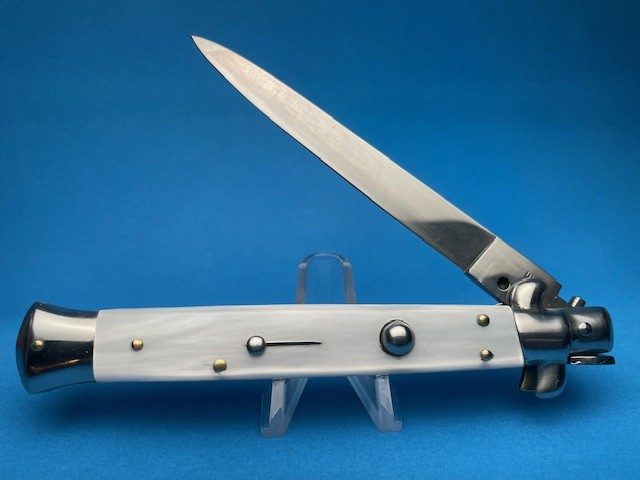Something is enduring about traditional blades. They tell stories, echo heritage, and carry a distinct presence that modern interpretations often fail to capture. Tucked into leather sheaths or displayed behind glass, these knives offer more than utility—they offer connection. Somewhere between steel and spring lies the allure of the Frank Beltrame Italian stiletto, a knife that merges old-world skill with contemporary fascination.
A Historical Thread in Every Detail
Every blade has a past. With the stiletto, that past winds through Renaissance Europe, weaving its way into duels, legends, and the quiet confidence of those who carried one. Characterized by its slender shape and iconic snap, this style of knife evolved into more than just a tool—it became a signature. Modern renditions pay homage to that same silhouette, bringing back details that collectors and enthusiasts recognize instantly.
Whether resting on a shelf or folded inside a pocket, these stilettos still carry whispers of their origin. There’s an unmistakable feeling when you hold one—like tracing a bloodline of craftsmanship that refuses to fade.
Design with Distinctive Appeal
Today’s styles strike a balance between nostalgia and subtle enhancements. While the structure remains faithful to traditional standards, certain refinements lend it a polished edge. Brass guards. Polished bolsters. Scales in pearlex, horn, or Brazilian wood. Each material tells its own story—some warm, some dark, others luminescent under light.
It’s in this attention to design that the Frank Beltrame Italian stilettos reveal their identity. Known for their strong springs and sleek profiles, they manage to feel both elegant and grounded. There’s no excess, no theatrics—just a well-made mechanism that speaks clearly through every click.
The Snap That Says Everything
Among knife enthusiasts, sound is an essential detail. That clean, confident snap signals quality without needing a second glance. For those familiar with Italian stilettos, the opening mechanism is not merely functional—it’s a defining feature.
This isn’t the hurried action of a spring-loaded gadget. It’s a measured movement, deliberate and satisfying. It invites repetition, often for no other reason than to feel it again. These knives become more than items—they become companions. Some carry them daily. Others keep them for special occasions or pass them down as heirlooms.
Built for Both Use and Display
Collectors know the delicate balance between form and function. Too ornamental, and the piece feels fragile. Too utilitarian, and it loses the subtle details that spark fascination. These stilettos rest comfortably in the middle.
From folding models to fixed-blade variants, the range caters to a diverse range of preferences. Each one is unique—no two scales are identical, no grain of horn or wood precisely matched. This natural variation, paired with hand-assembled mechanics, gives every piece a quiet individuality.
To say that these knives are made would be an understatement. They are assembled with care, guided by techniques that resist automation.
Precision Beyond the Blade
While aesthetics pulls people in, precision keeps them engaged. The balance of weight, the centered blade, the smooth action—all of it stems from a craftsman’s intuition. This becomes most apparent when comparing models. The ones that feel “right” have an effortless flow to their movement.
And with the Frank Beltrame Italian stiletto, that feeling arrives often. Collectors note its reliability, both in feel and construction. It’s this consistency that cements its reputation across knife communities. There are no surprises—only quiet confidence wrapped in steel and scale.
A Name with Reputation, Not Hype
Many collectors look for names that carry weight. Not marketing weight, but the kind forged from decades of reliable work. When people speak about Frank Beltrame Italian stilettos, it’s rarely about trends or flash—it’s about trust.
Built in Maniago, Italy, these stilettos originate from a region steeped in a tradition of blade-making. This setting infuses each knife with an unspoken standard. It’s not about reaching for something new. It’s about maintaining what has worked for generations.
From Collection to Legacy
Knives like these are rarely impulse buys. They’re chosen, appreciated, and often remembered. For many, the first stiletto becomes a starting point—an introduction to a wider world of handcrafted pieces. It’s not unusual for that first piece to remain a favorite, long after more elaborate or expensive models enter the rotation.
There’s a reason for that. It goes beyond materials or balance. It’s about presence—the sense that you’re holding a slice of history, finished with a personal touch. Whether displayed on a shelf or carried with care, they hold a role in people’s lives that extends beyond utility.
Closing with Character
Something is reassuring about knowing that craftsmanship still holds value in a fast-paced world. These stilettos serve as reminders that care, patience, and tradition can still define the things we carry. We often search for items that reflect our taste, our values, or our admiration for enduring quality.
When it comes to the Frank Beltrame Italian stiletto, that search ends in the smooth grain of the handle, the soft gleam of polished steel, and the unmistakable sound of a blade finding its place.


